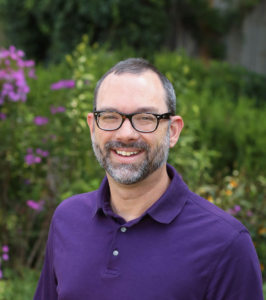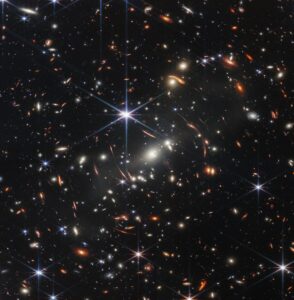
July 12, 2022. It was summer in the Northern Hemisphere, and there was light. It came from the farthest reaches of the cosmos. It came in two forms, simultaneously: as photons (particles) and waves (electromagnetic radiation). The particle-waves collided with mirrors on the James Webb Space Telescope, the most powerful telescope ever constructed, sometime in June 2022. On July 12, the U.S. National Aeronautics and Space Administration, the European Space Agency, and the Canadian Space Agency released the telescope’s first images to the public.
Each light particle-wave that touches the Webb Telescope is the product of collapse, of a fall, of destruction on a catastrophic scale that reveals fundamental, enduring patterns in the cosmos. The Webb photos are a revelation.
Photons emerge from a fall, during the process of collapse, which births stars. Stars form from interstellar gas and dust, which accumulates, producing gravitational force. As the mass of this accumulation increases, so does its gravity, which compresses the distance between atoms, generating heat until the cloud of gas and dust collapses in on itself. Temperatures continue to increase as collapse continues. When the core reaches 10,000 Kelvin, fusion reactions begin and nuclei merge, creating new elements. Photons emerge from these cauldrons of collapse. Within each of the collapses, there is a fall, as electrons descend from excited, higher-energy orbits to lower-energy orbits, producing photons in continual upheaval.
Electric fields with no charge and no resting mass, particle-waves of light have traveled through space and time since the beginning. Webb allows us to look farther back in time than ever before, to detect even the faintest light emanating some 14.6 billion years ago, within 1 billion years of the big bang.
One image, “SMACS 0723: Webb’s First Deep Field,” shows thousands of galaxies, each one of which is an entire world of gas, dust, and stars, usually 100 million of them, spanning 3,000 – 300,000 light years across, on average. The image, however, covers a piece of our sky that is only the size of one grain of sand, held at arm’s length by someone laying on the ground. In this “grain of sky” there is light. There is darkness. And there is dust, the material from which stars, and life itself, are made. In this “grain of sky,” there is a galaxy cluster, as it appeared 4.6 billion years ago, around the time the Earth formed from stardust and gas, pulled together by gravity.
We cannot know what this piece of the sky actually looks like now, in its moment. But we know that it must look different – there must have been much change: untold cycles of collapse, renewal, and creation.
Time is somewhat less elusive on this rock, Earth, where we do have much more tangible access to this moment. It is a moment that feels more unstable for many more of us. Twenty-one months into the Covid-19 pandemic, the world feels like it is teetering on the edge of an abyss. Above all, there is much death, and much destruction. It is a time of pestilence. Covid-19 has killed more than one million Americans, and life expectancy in the U.S. has decreased three full years since 2019, the steepest decline in nearly 100 years. The most vulnerable and marginalized among us – Native Americans and Alaska Natives – have experienced the sharpest reductions. It is a time of conflict, physical and symbolic. Russia’s brutal invasion of Ukraine threatens to envelop more of the world, in a potential reprise of the great wars of the 20th century. The U.S Capitol was the site of an insurrection on January 6, 2021, whose participants carried symbols of Fascism and the Confederacy into the seat of democracy, riding a wave of seething distrust and misinformation. It is a time of ecological destruction. After declining in 2020 due to the pandemic-induced economic shutdowns, carbon emissions resumed their climb and now exceed levels prior to the pandemic. Animal extinctions continue apace. Fires, floods, and droughts are occurring with increasing scope and intensity. The Great Salt Lake has lost 75% of its water since 1987. The Colorado River, the principal water source for seven states and 40 million people, is drying up. Water flows on China’s main river – the Yangtze – and source of hydropower are less than one-half of normal, forcing a shift back into coal use for energy. Water levels on the Rhine, the Danube, and the Volga are at century lows. On the Elbe, in the Czech Republic, water levels have dropped low enough to read the words, “If you see me, then weep,” chiseled into the stones around 1616.
The return of “normal” so many hoped for, in the early days of the pandemic does not seem to be on the horizon. Unprecedented has become our new normal. The word “collapse” is in more of our thoughts, and to the extent that we share them with others, our conversations, and it joins new words in our lexicon: “solastalgia” for the existential distress associated with climate change, and the variations of “doom” — “Doomers,” “doomscrolling,” and “Doomerism” for the new (old) forms of fatalism and pessimism that have re-emerged in our moment. There are calls for shrinking the economy. There are renewed calls to decrease the population (while leaving unstated the means of achieving this goal). There are calls to empty one-half of the Earth of humans. There are real efforts by the wealthiest among us to leave the planet altogether. The light captured by Webb arrives amid much darkness.
We are indeed living through many, simultaneous forms of collapse. And we always have. We are products of collapse.
We cannot know what this piece of the sky will actually look like in any future. But we know that it must look different – there must be much change. There will be cycles of collapse, renewal, and creation.
My child and I are down at the river this afternoon. Everything here is a remnant of the fall of electrons in the many cauldrons of collapse. The sun is bright, and my child is radiant in youth. I am looking at light shining on stardust.
My child picked up a pile of sand – dust holding sand, on a rock, suspended in the light of a collapsing, jubilant star. Together amid unceasing change. Together amid the very material of renewal.
There is light, today.
For in a grain of sky, there are entire worlds – worlds created and renewed through collapse. And from these worlds light still emerges. Some of the light has yet to arrive. And some of it is already with us, here, now.

Thanks for this Matt–thought provoking and context enlarging.